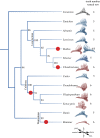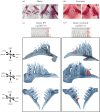Altered retinoic acid signalling underpins dentition evolution
- PMID: 25652838
- PMCID: PMC4344156
- DOI: 10.1098/rspb.2014.2764
Altered retinoic acid signalling underpins dentition evolution
Abstract
Small variations in signalling pathways have been linked to phenotypic diversity and speciation. In vertebrates, teeth represent a reservoir of adaptive morphological structures that are prone to evolutionary change. Cyprinid fish display an impressive diversity in tooth number, but the signals that generate such diversity are unknown. Here, we show that retinoic acid (RA) availability influences tooth number size in Cyprinids. Heterozygous adult zebrafish heterozygous for the cyp26b1 mutant that encodes an enzyme able to degrade RA possess an extra tooth in the ventral row. Expression analysis of pharyngeal mesenchyme markers such as dlx2a and lhx6 shows lateral, anterior and dorsal expansion of these markers in RA-treated embryos, whereas the expression of the dental epithelium markers dlx2b and dlx3b is unchanged. Our analysis suggests that changes in RA signalling play an important role in the diversification of teeth in Cyprinids. Our work illustrates that through subtle changes in the expression of rate-limiting enzymes, the RA pathway is an active player of tooth evolution in fish.
Keywords: cyprinids; development; evolution; retinoic acid; tooth.
© 2015 The Author(s) Published by the Royal Society. All rights reserved.
Figures




References
Publication types
MeSH terms
Substances
LinkOut - more resources
Full Text Sources
Other Literature Sources
Molecular Biology Databases

